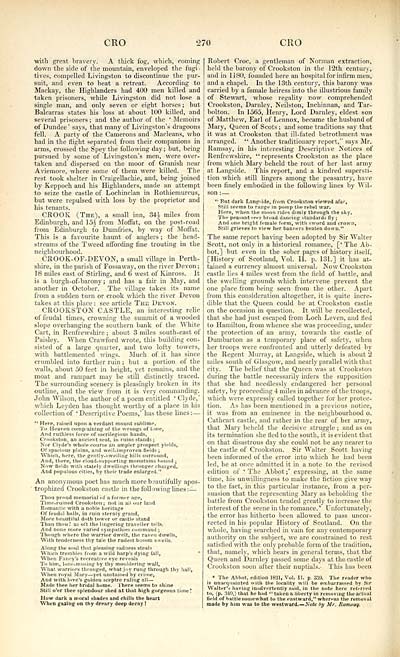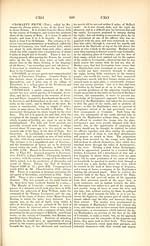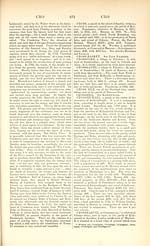Topographical, statistical, and historical gazetteer of Scotland > Volume 1
(352) Page 270
Download files
Complete book:
Individual page:
Thumbnail gallery: Grid view | List view

CRO
270
CRO
with great bravery. A thick fog, which, coming
down the side of the mountain, enveloped the fugi ■
tives, compelled Livingston to discontinue the pur-
suit, and even to beat a retreat. According to
Mackay, the Highlanders had 400 men killed and
taken prisoners, while Livingston did not lose a
single man, and only seven or eight horses ; but
Balcarras states his loss at about 100 killed, and
several prisoners ; and the author of the ' Memoirs
of Dundee' says, that many of Livingston's dragoons
fell. A party of the Camerons and Macleans, who
had in the flight separated from their companions in
arms, crossed the Spey the following day; but, being
pursued by some of Livingston's men, were over-
taken and dispersed on the moor of Granish near
Aviemore, where some of them were killed. The
rest took shelter in Craigellachie, and, being joined
by Keppoch and his Highlanders, made an attempt
to seize the castle of Lochinclan in Rothiemurcus,
but were repulsed with loss by the proprietor and
his tenants.
CROOK (The), a small inn, 34^ miles from
Edinburgh, and loh from Moffat, on the post-road
from Edinburgh to Dumfries, by way of Moffat.
This is a favourite haunt of anglers ; the head-
streams of the Tweed affording fine trouting in the
neighbourhood.
CROOK-OF-DEVON, a small village in Perth-
shire, in the parish of Fossaway, on the river Devon ;
18 miles east of Stirling, and 6 west of Kinross. It
is a burgh-of-barony ; and has a fair in May, and
another in October. The village takes its name
from a sudden turn or crook which the river Devon
takes at this place : see article The Devon.
CROOKSTON CASTLE, an interesting relic
of feudal times, crowning the summit of a wooded
slope overhanging the southern bank of the White
Cart, in Renfrewshire ; about 3 miles south-east of
Paisley. When Crawford wrote, this building con-
sisted of a large quarter, and two lofty towers,
with battlemented wings. Much of it has since
crumbled into further ruin ; but a portion of the
walls, about 50 feet in height, yet remains, and the
moat and rampart may be still distinctly traced.
The surrounding scenery is pleasingly broken in its
outline, and the view from it is very commanding.
John Wilson, the author of a poem entitled ' Clyde,'
which Leyden has thought worthy of a place in his
collection of ' Descriptive Poems,' has these lines : —
" Here, raised upon a verdant mount sublime,
To Heaven complaining of the wrongs of tune,
And ruthless force of sacrilegious hands,
Crookston, an ancient seat, in ruins stands;
Nor Clyde's whole course an ampler prospect yields,
Of spacious plains, and well-improven fields ;
Which, here, the gently-swelling hills surround,
And, there, the cloud-supporting mountains hound ;
Now fields with stately dwellings thronger charged.
And populous cities, by their trade enlarged.''
An anonymous poet has much more beautifully apos-
trophized Crookston castle in the following lines:—
Thou proud memorial of a former age,
Time-ruined Crookston ; not in all our land
Romantic with a noble heritage
Of feudal halls, in ruin sternly grand,
More beautiful doth tower or castle stand
Than thou ! as oft the lingering traveller tells.
And none more varied sympathies command ;
Though where the warrior dwelt, the raven dwells,
With tenderness thy tale the rudest bosom swells.
Along the soul that pleasing sadness steals
Which trembles from a wild harp's dying fall,
When Fancy's recreative eye reveals
To him, lone-musing by thy mouldering wall,
What warriors thronged, what joy rung through thy hall.
When royal Mary — yet unstained by crime,
And with love's golden sceptre ruling all —
Made thee her bridal home. There seems to shine
Still o'er thee splendour shed at that high gorgeous time!
How dark a moral shades and chills the heart
When gazing on thy dreary deep decay !
Robert Croc, a gentleman of Norman extraction,
held the barony of Crookston in the 12th century,
and in 1180, founded here an hospital for infirm men,
and a chapel. In the 13th century, this barony was
carried by a female heiress into the illustrious family
of Stewart, whose regality now comprehended
Crookston, Darnley, Neilston, Inchinnan, and Tar-
bolton. In 1565, Henry, Lord Darnley, eldest son
of Matthew, Earl of Lennox, became the husband of
Mary, Queen of Scots ; and some traditions say that
it was at Crookston that ill-fated betrothment was
arranged. " Another traditionary report," says Mr.
Ramsay, in his interesting Descriptive Notices of
Renfrewshire, " represents Crookston as the place
from which Mary beheld the rout of her last army
at Langside. This report, and a kindred supersti-
tion which still lingers among the peasantry, have
been finely embodied in the following lines by Wil-
son : —
" But dark Langside, from Crookston viewed afar,
Still seems to raege in pomp the rebel war.
Here, when the moon rides dimly through the sky.
The peasant sees broad dancing standards fly;
And one bright female form, with sword and crown,
Still grieves to view her banners beaten down."
The same report having been adopted by Sir Walter
Scott, not only in a historical romance, [' The Ab-
bot,] but even in the sober pages of history itself,
[History of Scotland, Vol. II. p. 131.] it has at-
tained a currency almost universal. Now Crookston
castle lies 4 miles west from the field of battle, and
the swelling grounds which intervene prevent the
one place from being seen from the other. Apart
from this consideration altogether, it is quite incre-
dible that the Queen could be at Crookston castle
on the occasion in question. It will be recollected,
that she had just escaped from Loch Leven, and fled
to Hamilton, from whence she was proceeding, under
the protection of an army, towards the castle of
Dumbarton as a temporary place of safety, when
her troops were confronted and utterly defeated by
the Regent Murray, at Langside, which is about 2
miles south of Glasgow, and nearly parallel with that
city. The belief that the Queen was at Crookston
during the battle necessarily infers the supposition
that she had needlessly endangered her personal
safety, by proceeding 4 miles in advance of the troops,
which were expressly called together for her protec-
tion. As has been mentioned in a previous notice,
it was from an eminence in the neighbourhood o.
Cathcart castle, and rather in the rear of her army,
that Mary beheld the decisive struggle ; and as on
its termination she fled to the south, it is evident that
on that disastrous day she could not be any nearer to
the castle of Crookston. Sir Walter Scott having
been informed of the error into which he had been
led, he at once admitted it in a note to the revised
edition of ' The Abbot ;' expressing, at the same
time, his unwillingness to make the fiction give way
to the fact, in this particular instance, from a per-
suasion that the representing Mary as beholding the
battle from Crookston tended greatly to increase the
interest of the scene in the romance.* Unfortunately,
the error has hitherto been allowed to pass uncor-
rected in his popular History of Scotland. On the
whole, having searched hi vain for any contemporary
authority on the subject, we are constrained to rest
satisfied with the only probable form of the tradition,
that, namely, which bears in general terms, that the
Queen and Darnley passed some days at the castle of
Crookston soon after their nuptials.- This has been
« The Abbot, edition 1831, Vol. II. p. 339. The reader who
is unacquainted with the locality will be embarrassed by Sir
Walter's having inadvertently said, in the note here referred
to, (p. 340,) that he had " taken a liberty in removing the actual
field of battle somewhat to the eastward," whereas the removal
made by him was to the westward. — Note by Mr. Ramsay.
270
CRO
with great bravery. A thick fog, which, coming
down the side of the mountain, enveloped the fugi ■
tives, compelled Livingston to discontinue the pur-
suit, and even to beat a retreat. According to
Mackay, the Highlanders had 400 men killed and
taken prisoners, while Livingston did not lose a
single man, and only seven or eight horses ; but
Balcarras states his loss at about 100 killed, and
several prisoners ; and the author of the ' Memoirs
of Dundee' says, that many of Livingston's dragoons
fell. A party of the Camerons and Macleans, who
had in the flight separated from their companions in
arms, crossed the Spey the following day; but, being
pursued by some of Livingston's men, were over-
taken and dispersed on the moor of Granish near
Aviemore, where some of them were killed. The
rest took shelter in Craigellachie, and, being joined
by Keppoch and his Highlanders, made an attempt
to seize the castle of Lochinclan in Rothiemurcus,
but were repulsed with loss by the proprietor and
his tenants.
CROOK (The), a small inn, 34^ miles from
Edinburgh, and loh from Moffat, on the post-road
from Edinburgh to Dumfries, by way of Moffat.
This is a favourite haunt of anglers ; the head-
streams of the Tweed affording fine trouting in the
neighbourhood.
CROOK-OF-DEVON, a small village in Perth-
shire, in the parish of Fossaway, on the river Devon ;
18 miles east of Stirling, and 6 west of Kinross. It
is a burgh-of-barony ; and has a fair in May, and
another in October. The village takes its name
from a sudden turn or crook which the river Devon
takes at this place : see article The Devon.
CROOKSTON CASTLE, an interesting relic
of feudal times, crowning the summit of a wooded
slope overhanging the southern bank of the White
Cart, in Renfrewshire ; about 3 miles south-east of
Paisley. When Crawford wrote, this building con-
sisted of a large quarter, and two lofty towers,
with battlemented wings. Much of it has since
crumbled into further ruin ; but a portion of the
walls, about 50 feet in height, yet remains, and the
moat and rampart may be still distinctly traced.
The surrounding scenery is pleasingly broken in its
outline, and the view from it is very commanding.
John Wilson, the author of a poem entitled ' Clyde,'
which Leyden has thought worthy of a place in his
collection of ' Descriptive Poems,' has these lines : —
" Here, raised upon a verdant mount sublime,
To Heaven complaining of the wrongs of tune,
And ruthless force of sacrilegious hands,
Crookston, an ancient seat, in ruins stands;
Nor Clyde's whole course an ampler prospect yields,
Of spacious plains, and well-improven fields ;
Which, here, the gently-swelling hills surround,
And, there, the cloud-supporting mountains hound ;
Now fields with stately dwellings thronger charged.
And populous cities, by their trade enlarged.''
An anonymous poet has much more beautifully apos-
trophized Crookston castle in the following lines:—
Thou proud memorial of a former age,
Time-ruined Crookston ; not in all our land
Romantic with a noble heritage
Of feudal halls, in ruin sternly grand,
More beautiful doth tower or castle stand
Than thou ! as oft the lingering traveller tells.
And none more varied sympathies command ;
Though where the warrior dwelt, the raven dwells,
With tenderness thy tale the rudest bosom swells.
Along the soul that pleasing sadness steals
Which trembles from a wild harp's dying fall,
When Fancy's recreative eye reveals
To him, lone-musing by thy mouldering wall,
What warriors thronged, what joy rung through thy hall.
When royal Mary — yet unstained by crime,
And with love's golden sceptre ruling all —
Made thee her bridal home. There seems to shine
Still o'er thee splendour shed at that high gorgeous time!
How dark a moral shades and chills the heart
When gazing on thy dreary deep decay !
Robert Croc, a gentleman of Norman extraction,
held the barony of Crookston in the 12th century,
and in 1180, founded here an hospital for infirm men,
and a chapel. In the 13th century, this barony was
carried by a female heiress into the illustrious family
of Stewart, whose regality now comprehended
Crookston, Darnley, Neilston, Inchinnan, and Tar-
bolton. In 1565, Henry, Lord Darnley, eldest son
of Matthew, Earl of Lennox, became the husband of
Mary, Queen of Scots ; and some traditions say that
it was at Crookston that ill-fated betrothment was
arranged. " Another traditionary report," says Mr.
Ramsay, in his interesting Descriptive Notices of
Renfrewshire, " represents Crookston as the place
from which Mary beheld the rout of her last army
at Langside. This report, and a kindred supersti-
tion which still lingers among the peasantry, have
been finely embodied in the following lines by Wil-
son : —
" But dark Langside, from Crookston viewed afar,
Still seems to raege in pomp the rebel war.
Here, when the moon rides dimly through the sky.
The peasant sees broad dancing standards fly;
And one bright female form, with sword and crown,
Still grieves to view her banners beaten down."
The same report having been adopted by Sir Walter
Scott, not only in a historical romance, [' The Ab-
bot,] but even in the sober pages of history itself,
[History of Scotland, Vol. II. p. 131.] it has at-
tained a currency almost universal. Now Crookston
castle lies 4 miles west from the field of battle, and
the swelling grounds which intervene prevent the
one place from being seen from the other. Apart
from this consideration altogether, it is quite incre-
dible that the Queen could be at Crookston castle
on the occasion in question. It will be recollected,
that she had just escaped from Loch Leven, and fled
to Hamilton, from whence she was proceeding, under
the protection of an army, towards the castle of
Dumbarton as a temporary place of safety, when
her troops were confronted and utterly defeated by
the Regent Murray, at Langside, which is about 2
miles south of Glasgow, and nearly parallel with that
city. The belief that the Queen was at Crookston
during the battle necessarily infers the supposition
that she had needlessly endangered her personal
safety, by proceeding 4 miles in advance of the troops,
which were expressly called together for her protec-
tion. As has been mentioned in a previous notice,
it was from an eminence in the neighbourhood o.
Cathcart castle, and rather in the rear of her army,
that Mary beheld the decisive struggle ; and as on
its termination she fled to the south, it is evident that
on that disastrous day she could not be any nearer to
the castle of Crookston. Sir Walter Scott having
been informed of the error into which he had been
led, he at once admitted it in a note to the revised
edition of ' The Abbot ;' expressing, at the same
time, his unwillingness to make the fiction give way
to the fact, in this particular instance, from a per-
suasion that the representing Mary as beholding the
battle from Crookston tended greatly to increase the
interest of the scene in the romance.* Unfortunately,
the error has hitherto been allowed to pass uncor-
rected in his popular History of Scotland. On the
whole, having searched hi vain for any contemporary
authority on the subject, we are constrained to rest
satisfied with the only probable form of the tradition,
that, namely, which bears in general terms, that the
Queen and Darnley passed some days at the castle of
Crookston soon after their nuptials.- This has been
« The Abbot, edition 1831, Vol. II. p. 339. The reader who
is unacquainted with the locality will be embarrassed by Sir
Walter's having inadvertently said, in the note here referred
to, (p. 340,) that he had " taken a liberty in removing the actual
field of battle somewhat to the eastward," whereas the removal
made by him was to the westward. — Note by Mr. Ramsay.
Set display mode to: Large image | Transcription
Images and transcriptions on this page, including medium image downloads, may be used under the Creative Commons Attribution 4.0 International Licence unless otherwise stated. ![]()
| Gazetteers of Scotland, 1803-1901 > Topographical, statistical, and historical gazetteer of Scotland > Volume 1 > (352) Page 270 |
|---|
| Permanent URL | https://digital.nls.uk/97441770 |
|---|
| Description | Volume first. A-H. |
|---|---|
| Attribution and copyright: |
|

